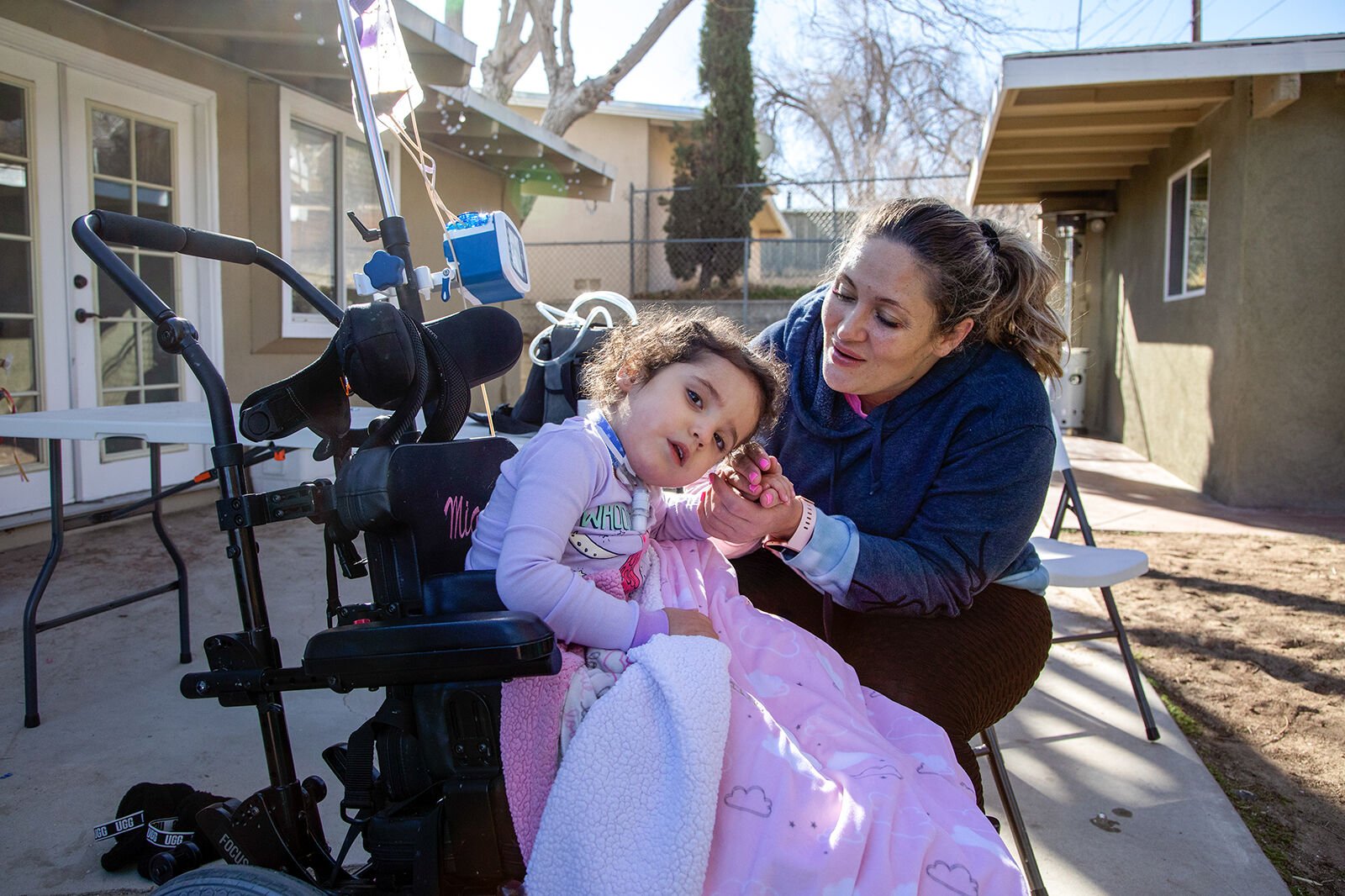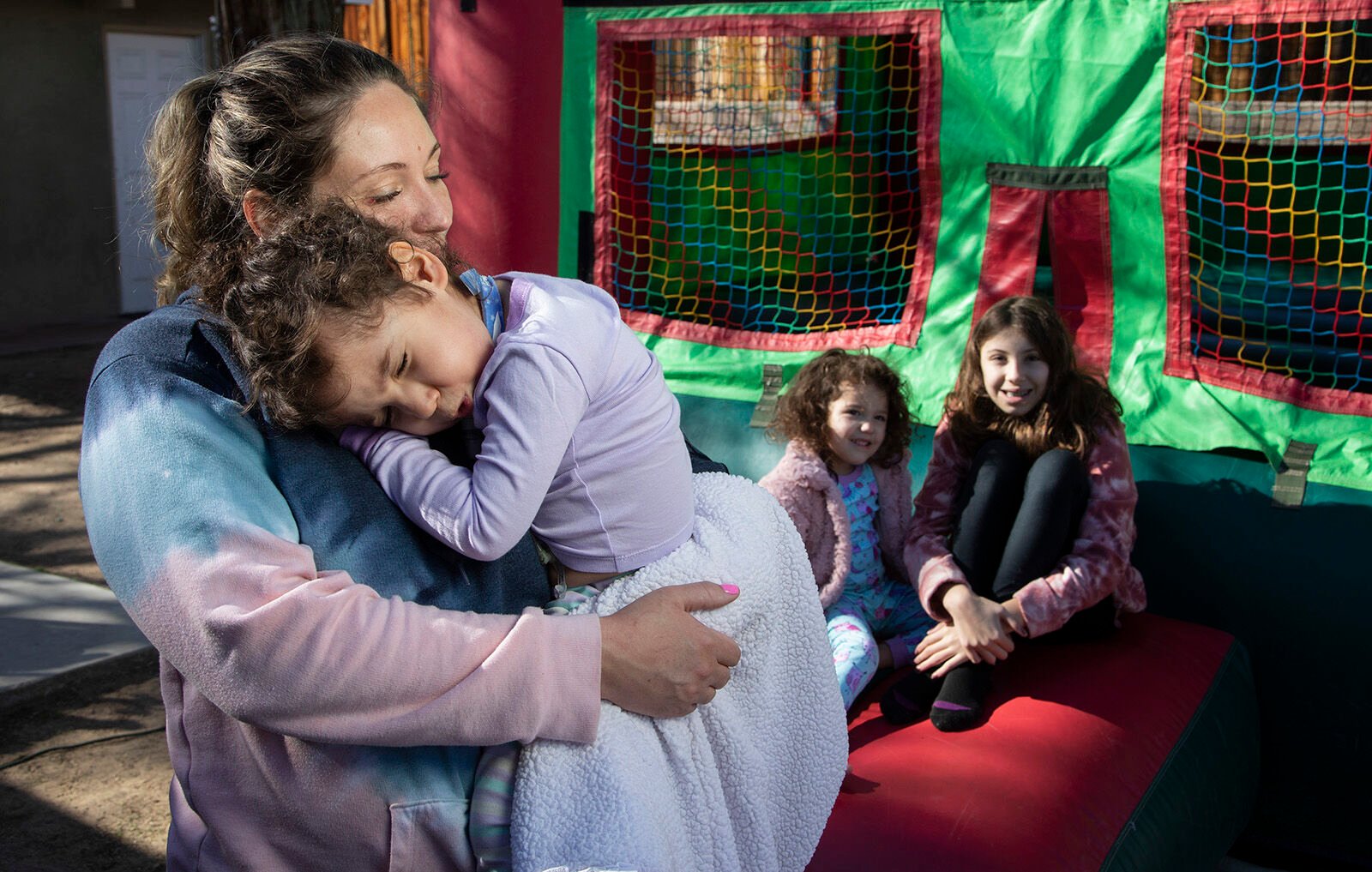Parents struggle to get home nurses for medically fragile kids

Myung J. Chun/Los Angeles Times
Amber Suarez sits with her 3-year-old daughter Mia, who needs the care of home nurses. During the pandemic, those nurses have been harder to find and keep.
LOS ANGELES — To make sure her 3-year-old daughter survived the night on her ventilator, Amber Suarez stayed awake for four hours, then woke up her husband to watch Mia for another four hours as the girl dozed.
It had already been months since the family lost a nurse who assisted them during the day, which meant Suarez had been caring for her disabled daughter since the morning, juggling the needs of Mia and her twin sister, Savannah. She feeds her through a gastrostomy tube, administers breathing treatments, and suctions out fluid from the tube that helps her breathe.
Mia is also supposed to have a nurse at her side by night, but Suarez said the night nurse hadn’t shown up that Friday. The next night, another nurse missed her scheduled shift, forcing her and her husband to stay up again, Suarez said.
“I’m just so desperate for a break. Just a breather so I can do simple things like cook breakfast, go to the bathroom, shower,” said Suarez, a mother of three in Palmdale, Calif. “I can’t leave her alone. She likes to pull out her trach” — the breathing tube surgically inserted into her windpipe. “I’m just trying to keep my daughter alive.”
Families have long struggled to get nursing care at home for medically fragile children. Even after doctors have deemed home care necessary to keep their kids healthy and safe, many have been unable to secure enough nurses to fill their allocated hours.
Parents and advocates say that, despite efforts to tackle the problem before the pandemic, it has persisted with the arrival of COVID-19. Home health agencies say it has been harder to hang on to nurses when other businesses are recruiting them to handle new demands tied to the coronavirus, including administering tests and vaccines.
“COVID didn’t create a problem that wasn’t there,” said Jennifer McLelland, a member of the advocacy group Little Lobbyists. “COVID just made everything worse.”
A decade ago, McLelland had so much trouble lining up home nursing for her then-infant son that it took three months before he could be released from the hospital and go home to Fresno County.
The family ended up moving from a rural town to the Fresno suburbs to have a better shot at finding nurses for her son, who has a rare genetic condition and has a feeding tube and a tracheostomy. At night, they need to keep reconnecting his ventilator when the 10-year-old rolls over and disconnects the machine in his sleep.
If no nurse is there, “we really just don’t get any sleep,” McLelland said. And “when parents are exhausted, when they’re not getting nights of sleep, the risk of getting things wrong is death.”

Myung J. Chun/Los Angeles Times
Amber Suarez with her 3-year-old daughter Mia, who needs the care of home nurses. Her other daughters are Savannah, rear left, who is Mia’s identical twin, and 12-year-old Isabella.
Years before the pandemic, the California Department of Health Care Services found in one study that 29% of home nursing hours authorized through a Medi-Cal program for children were not being filled. Another analysis, funded by the home health agency Maxim Healthcare Services, found that the majority of California home health agencies surveyed could only provide a quarter — or less — of the nursing hours approved for their Medi-Cal patients.
Four years ago, attorneys with Disability Rights California and other groups took the state to court, arguing that systemic failures to arrange for home nurses put children at serious risk of injury, hospitalization and institutionalization. The lawsuit centered on children and teens who are authorized to get home nursing through Medi-Cal.
Attorneys ultimately secured a settlement requiring case managers to assist families with getting nurses. Before the pandemic arrived, the state also used money from a cigarette tax to increase its rates for home nursing for children under Medi-Cal, amid complaints from agencies that the rates had been too low to recruit and retain nurses.
Home care for kids, which relies heavily on public funding, “has traditionally lagged behind the other opportunities that nurses have,” said Michael Davidov, president of American United Home Care. Davidov said the Medi-Cal rate increase had helped four years ago, but now “COVID has turbocharged the disparity.”
The gaps in nursing care have made it impossible for many parents to work regular hours and strained families already frazzled by the enduring pandemic. Suarez grows frustrated whenever a nurse fails to show up, but fears that if she lets one go, it will be impossible to find another one.
